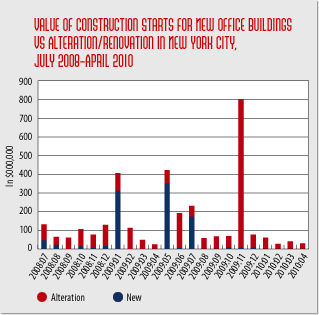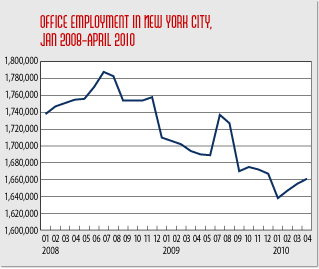
NYC office construction starts down sharply, but conditions exist for rebound as economy recovers
Recent Increases in Net Absorption and Office Employment, Combined with Lack of Overbuild in Previous Decades, Point to Future Demand for New Construction
New York City office construction starts have declined sharply in the midst of a global economic downturn, but a rebound in this sector may not be far off, according to a New York Building Congress review of multiple data sources.
The value of office construction starts reached $163 million in the first four months of 2010. At this pace, the value of starts in this sector would total just $489 million in 2010, compared to $2.6 billion in 2009 and $1.3 billion in 2008. The data encompass all project starts, including new construction as well as alterations and renovations to existing structures, and reflect the estimated value of each initiated project through the entire period of construction.
The vast majority of office construction starts presently is in the alterations and renovations category rather than new ground-up construction. For the first four months of 2010, alterations accounted for more than 99 percent of all construction starts as measured by value ($162.3 million vs. $700,000 in new construction). In 2009, alterations accounted for $1.7 billion of the $2.6 billion in office starts.
"As office tower projects, such as Goldman Sachs and 11 Times Square, were completed, the projects we hoped would replace them, such as the Gem Tower and 250 West 55th Street, are on hold," said Building Congress President Richard T. Anderson. "With the exception of the World Trade Center Towers 1 and 4, and the Gotham Center project in Long Island City, new office construction is at a virtual standstill, and this sector is subsisting on work generated by companies that are either renovating in place or relocating to other existing space."
While the data do not suggest that a dramatic turnaround is imminent, a review of historical construction data, as well as recent employment and leasing trends, suggest that, for the next few years, the office market outlook will be one of gradual absorption of available space, potentially followed by renewed expansion.
In 2008 and 2009, the amount of occupied office space in Manhattan's Central Business District declined by 23.3 million square feet. That trend, however, reversed in the last quarter of 2009, when a net of 1.3 million square feet was absorbed by office tenants. Based on the first five months of 2010, the Building Congress estimates that another 3 million square feet of space will be absorbed in Manhattan's CBD this year.
Similarly, office leasing appears to have bottomed out and is slowly rising again. Office leasing declined from 30 million square feet leased in 2006 to 17 million square feet in 2008, before leveling off at 16.5 million square feet in 2009. The Building Congress projects at least 21 million square feet of office space will be leased in 2010, based on the first five months of data for the year.
And while office employment remains well below its peak, 23,500 office jobs have been added to the economy since the start of 2010.
The Central Business District availability rate, which measures space that is actively being marketed and available for tenant build-out in the next 12 months, stood at 13.9 percent in May, down from 14.3 percent in March 2010. The CBD's vacancy rate, which is a measure of unoccupied and available space, is currently 9.4 percent. These numbers would have been considerably higher had New York City experienced an office building boom on a par with the late 1980s.
From 2005 to the present, just 12 office buildings, comprising approximately 12 million square feet of space, opened in New York City. Conversely, some 50 new office buildings, totaling 35 million square feet, were completed during a six-year period from 1985 and 1990. The overbuilding of that era left New York City with a glut of speculative office space that took years to fill.
"New York is fortunate in that we did not overbuild in the office sector during the recent economic boom, unlike in previous cycles," added Mr. Anderson. "This should ensure that currently available office space will lease up and rents can rebound relatively quickly as office employment recovers. It may take a few years to get there, but once vacancy rates return to 6 or 7 percent, we likely will see an improvement in new office building starts."
Charts and Diagrams

Source: McGraw-Hill Construction/Dodge Market Forecast and Analysis Services *

Source: CBRE and Urbanomics

Source: NYS Department of Labor and Urbanomics
*Dodge data used for this analysis can be purchased at dodge.construction.com.



